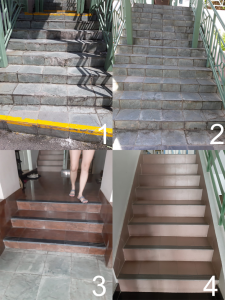What the Ancient Greeks and Architecture May Tell Us About Accessibility


The August 2020 issue of the archaeological journal Antiquity contained a fascinating look at ancient Greek architecture titled, “The architecture of access: ramps at ancient Greek healing sanctuaries.” It was written by Debby Sneed, a classicist at California State University, Long Beach.
Sneed contends that “the ancient Greeks made architectural choices that enabled individuals with impaired mobility to access certain spaces where relatively large numbers of disabled individuals were expected to visit.” Basically, she theorizes that if the disabled and sick were expected to petition for healing at healing sanctuaries, their needs would be taken into account when the architects drafted their building plans.
To convince readers of her case, she highlights two healing sanctuaries built in Epidauros and Corinth, and compares the number of ramps built at those sites to others like the Temple of Zeus at Olympia.
Not everyone agrees with Sneed, as Smithsonian Magazine pointed out. Among her critics are Katja Sporn, director of the German Archaeological Institute’s Athens Department, and Alessandro Pierattini, an assistant professor at the University of Notre Dame’s School of Architecture. Sporn believes the ramps were multipurpose, designed to “help everyone, also disabled people, walk into temples better,” while Pierattini argues that a larger sample size of healing sanctuaries should have been examined, as Gizmodo reported.
But whether or not you agree with Sneed’s findings, we cannot dispute that the architecture of a building can tell us exactly who it is intended to serve — and inadvertently, who it isn’t intended to serve.
In my last column, I mentioned my family’s move to a new place here in Singapore, and my struggle to adapt to it. Because I was stressed about the move and wanted the column to be a pep talk for myself and for readers, I left out one of the main reasons for my unease: The new place is accessible only via stairs. Three flights and three steps, to be exact.
Perhaps “accessible” is the wrong word to use when the house obviously is not accessible. In fact, it puts my caregivers at risk of acquiring a disability themselves each time we have an outing, as they must carry my wheelchair and me up and down the steps. My family almost passed on the unit because of its inaccessibility. I told my friend and fellow columnist Brianna Albers that I would become Rapunzel if we went through with the move.
Why did my family go through with it, then? Why did I agree? Because my brother needed the extra room to study, and every other unit my parents looked at was either out of their budget or lacked the bathroom space for me. (And there is something to be said about how a lack of finances and a lack of space are also disability issues, but those are topics for another time.)
seriously. i have to use a wheelchair and hydrotherapy equipment. i can't bathe or use the toilet on my own. there's no way a house with a bathroom as large as one slim-jim of a person will be able to accommodate me
— sherry aka elisa. (@sherlisass) February 25, 2021
That didn’t mean I was happy we had to rent an inaccessible place. Besides my concern for my caregivers, I have an intense fear of injury from a bad fall I had at 15. Therefore, I was unable to function in the days leading up to moving day. I couldn’t stop spiraling into scenarios where I would need an ambulance, and the panic would cause someone else to trip and fall down the stairs with me.
Although I knew I wouldn’t find a solution, I went down a rabbit hole of portable ramps just to manage my need to feel safe. Even now, the mere thought of the stairs fills me with dread.
Eventually, I got through the move safe and sound. And I know that despite my fears, my family and I will take every precaution we need to and adapt to the situation. But the thing is, we shouldn’t have to.
The ancient Greeks were conscious of disabled needs more than 2,000 years ago. There’s a possibility their architects knew that the language of their architecture would declare whom their buildings were intended to serve.
While I don’t think the architects of my home built it to deliberately keep disabled people out, I don’t think they considered our needs, either. Nor did they consider that homes, and the outside world, could also be places of healing.
Philosopher Simon Critchley writes in “Tragedy, the Greeks, and Us” that, “When revived, we will notice that when the ancients speak, they do not merely tell us about themselves. They tell us about us.”
The Americans with Disabilities Act wasn’t a law in the U.S. until 1990. Singapore didn’t join the United Nations’ Convention on the Rights of Persons with Disabilities until 2012. Singapore’s Housing Development Board didn’t launch programs to install ramps and wheelchair lifts in public housing until 2018 — 21 years after the private condo I live in was built.
After reading Sneed’s article, I can’t help but wonder why modern societies took so long to recognize the necessity of accessibility.
***
Note: SMA News Today is strictly a news and information website about the disease. It does not provide medical advice, diagnosis, or treatment. This content is not intended to be a substitute for professional medical advice, diagnosis, or treatment. Always seek the advice of your physician or other qualified health provider with any questions you may have regarding a medical condition. Never disregard professional medical advice or delay in seeking it because of something you have read on this website. The opinions expressed in this column are not those of SMA News Today, or its parent company, BioNews, and are intended to spark discussion about issues pertaining to spinal muscular atrophy.
The post What the Ancient Greeks and Architecture May Tell Us About Accessibility appeared first on SMA News Today.




